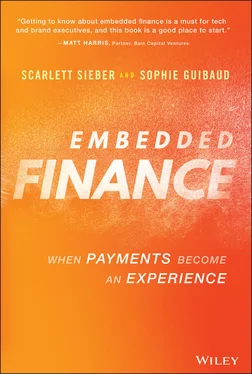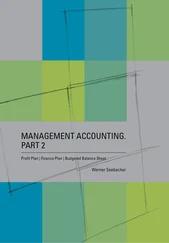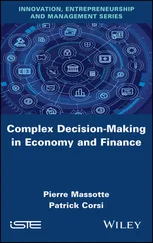Though technological innovation is expensive, it is worth the investment, as paying humans to interact with other humans every step of the way (even to check one's balance in a checking account) is even more expensive and does not provide the benefit of scale. The consumer, using sophisticated technology platforms and tools available nowadays, is serving herself and guiding the actions. This means that she should be able to perform the same transaction at 3 AM that she could at 3 PM, and can do it just as well from home or on a train as at the bank branch. She interacts when it is most convenient for her that naturally intertwines with her everyday lifestyle. As we will see, embedded finance takes this key idea even further.
But to return to 2008, financial services in this era still relied on physical locations to deliver products and services to their customers. Branch tellers and their cordoned-off lines were a familiar sight for millions of consumers every day. But bank branches were expensive to maintain, from rent to cleaning to utilities to supplies to employee salaries, and more. To offset these costs, banks had to make revenue elsewhere, like any other business, or think of a way to reduce those costs drastically. The end result of this necessary cost of doing business negatively impacted the customer. Banks retreated from certain products to focus on others, and fintech entered the breach.
One thing that fintechs collectively aren't focusing on is building storefronts. Since 2008, the US has seen a 12% decline in the number of bank branches. 2 In the UK the drop is even more dramatic—a 17% decline since the financial crisis struck in 2008. 3 These declines are to be expected as digital banking is adopted. Indeed, bank branches have been in general decline since the 1980s, as card payments have taken transactions away from cash, and telephone and internet banking offered different means to transfer money. As you might infer from these numbers, digital banks have had more success in the UK than in the US. Particularly for small businesses, digital offerings in the US financial services sector still have a long way to go. Its revenue model is not aligning with customer needs, because banks make money when customers make mistakes. When customers don't pay back their loans on time, or spend more than they have in their accounts, the banks profit. When customers are financially healthy, banks can earn money alongside them, instead of against them.
A word here about the basic revenue model for a bank. Banks earn revenue by providing loans, including home loans (mortgages), auto loans, business loans, and personal loans, including credit cards, and from interchange fees received from card payments. For the privilege of borrowing money, consumers and businesses pay interest. Banks also hold customer deposits, and sometimes charge for this service. These deposits provide the capital to make loans.
Customer needs have changed, and the customer base has grown younger and more diverse. New products and services are required to meet the new customers’ needs. Consider how radically other industries have changed over recent decades. It is happening in banking too, but up until now banking has lagged behind the rest of the economy.
CATASTROPHE AS THE MOTHER OF INVENTION
The financial crisis of 2008 resulted from a cascade of causes within the banking industry and in society at large. Loose regulations led to irresponsible lending and borrowing, particularly in the mortgage sector, and then losses from failed loans led to catastrophe for consumers and financial institutions alike. Ivy League graduates formerly flocked to the large investment banks and the secure life they promised, but in 2008 this changed forever. The five largest investment banks at that time were Goldman Sachs, Merrill Lynch, Morgan Stanley, Bear Stearns, and Lehman Brothers. All five were severely compromised by toxic assets (mortgages in default) that were worse than worthless—they were negative equity.
Lehman Brothers went bankrupt in September of 2008, the largest bankruptcy filing in American history, and disappeared. Bear Stearns also failed and was bought for a fraction of its previous value by JP Morgan Chase. Merrill Lynch was similarly acquired by Bank of America. A week after Lehman's collapse, Goldman Sachs and Morgan Stanley announced they would become traditional banks offering deposit services to retail customers. American Express also became a bank around this time. This move afforded the banks more protections by bringing them under closer supervision from federal agencies, which was, for a brief period, an attractive prospect. Japan's MUFG Bank subsequently bought a considerable portion of Morgan Stanley, which also borrowed more than $100 billion from the federal government, more than any other financial institution. Goldman Sachs has since seen considerable success innovating on the retail model with its digital bank, Marcus, named for the company's founder, Marcus Goldman, and more recently with its newly launched transaction banking division and TxB platform, which already supports embedded finance use cases.
The financial crisis resulted in a significant tightening of consumer credit, with some banks pulling back entirely from lending to consumers and small businesses outside of established channels such as credit cards. Just because banks no longer wanted to lend didn't mean that the needs of consumers and small businesses changed. They still needed to borrow money, but the traditional providers were no longer available.
THE TECHNOLOGY THAT MAKES IT POSSIBLE
Smartphones, following the birth of the iPhone in 2007, came of age in the wake of the financial crisis, delivering internet access and computing power to consumers wherever and whenever they wanted it. Apple sold nearly 1.5 billion iPhones in the 2010s, according to company sales figures. Here are a few data points to consider. Nearly all adult Americans (97%) own a mobile phone. Most (85%) of adult Americans own a smartphone, and 62% of them have made a purchase on the device. 4 The average amount of time a person spends interacting with a smartphone is more than three hours per day.
As of May 2021, China counted more than 911 million smartphone users, and India 440 million. The US was next with 270 million users, out of a population of 329 million. One of the marks of a highly developed economy is the percentage of its population that uses a smartphone. The cutoff is generally 70%, though Japan is a notable exception at only 60%.
Deloitte estimated in 2018 that 59% of the global population had used mobile phones for banking needs. 5 This number is likely considerably higher today, especially in response to the pandemic and an acceleration of digital adoption.
As smartphones proliferated in the developed world, feature phones, mobile phones with internet access but lacking the advanced interface of a smartphone, became ubiquitous in the developing world, including the Global South, such as Latin America, Southeast Asia, and Africa. While smartphones allowed consumers in developed nations to avoid the bank branch for everyday issues and to make purchases, feature phones allowed consumers in countries with underdeveloped financial systems and very few bank branches to access financial services for the first time.
Most consumers, some 70%, in Latin America and Africa are underbanked, meaning they lack access to traditional financial services. The transformation of financial services in countries that had underdeveloped banking infrastructure is far more dramatic than the changes happening in countries with advanced banking systems. Smartphone penetration is also expanding rapidly in the Global South, and with it, so are more sophisticated financial services. Brazil counts 110 million smartphone users, and Indonesia,160 million.
Читать дальше












